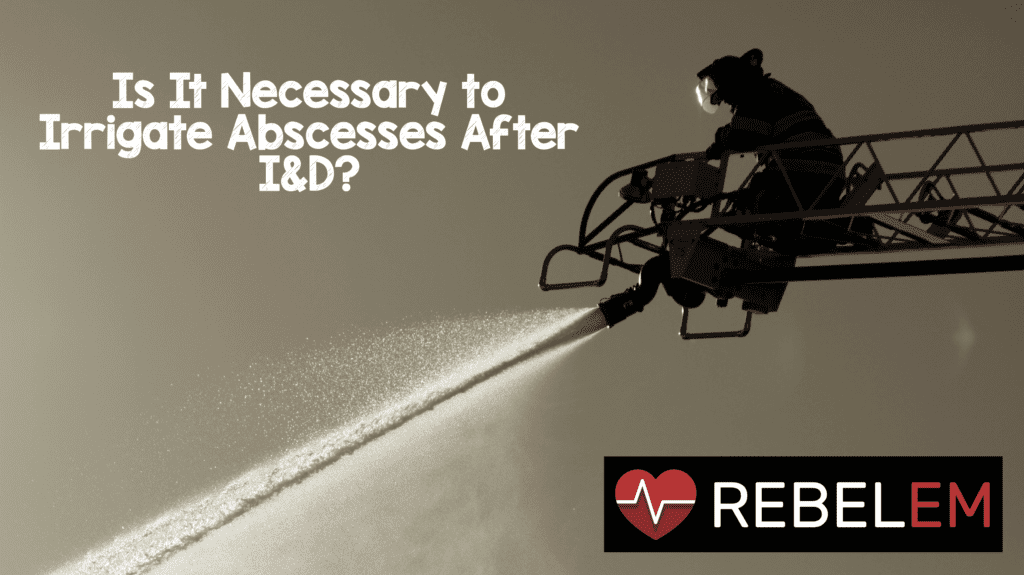
 Background: Irrigation after incision and drainage (I&D) of an abscess in the ED is considered by some sources to be standard care but local practice varies considerably. There are no randomized controlled trials to date that look at the potential benefits of this procedure. Irrigation increases the time required for the procedure and increases pain experienced by the patient.
Background: Irrigation after incision and drainage (I&D) of an abscess in the ED is considered by some sources to be standard care but local practice varies considerably. There are no randomized controlled trials to date that look at the potential benefits of this procedure. Irrigation increases the time required for the procedure and increases pain experienced by the patient.
Clinical Question: Does irrigation of the abscess cavity after I&D reduce the need for further intervention (repeated I&D, antibiotic change, abscess-related hospital admission)?
Article:
Chinnock B, Hendey GW. Irrigation of cutaneous abscesses does not improve treatment success. Ann Emerg Med 2016; 67(3): 379-83. PMID: 26416494
Population: All ED patients > 18 years of age with a cutaneous abscess
Intervention: I&D and irrigation
Control: I&D alone
Outcome (Primary): Need for further intervention after initial I&D at 30 day follow up (Repeated I&D, antibiotic change, abscess-related hospital admission)
Design: Prospective, randomized, nonblinded, single-center trial
Excluded:
- Pregnancy
- In police custody or prison resident
- Admission to the hospital
- Operating room incision and drainage
- Inability to follow up in 48 hours or to provide contact information for 30-day follow-up
Primary Results
- 209 patients enrolled
- 187 patients completed follow up (89.5%)
-
Differences between groups (irrigation vs. non-irrigation)
- Mean age: 36 vs. 40
- Packing: 89% vs. 75%
- Antibiotics: 91% vs. 73%
Critical Findings
- Need for further intervention at 30 days: 15% (irrigation group) vs 13% (non-irrigation group)
- Absolute difference 2% (CI -8 – 12%)
- No statistically significant difference
Strengths:
- Only randomized trial comparing irrigation to no irrigation of abscesses in the ED
- Patients were enrolled 24 hours a day, 7 days a week
- Although there were differences between groups (see primary results) the differences favored the irrigation group
- Follow-up was adequate (> 80%)
- The research associate who contacted the patient at 30 day follow up was blinded to treatment allocation
Limitations:
- The primary outcome measure relied on patient recall of further care required within 30 days of initial treatment.
- The study assumed a 20% failure rate and powered the study to detect a 15% difference between groups. This level of difference may be over-ambitious
- The study was not blinded as both patients and clinicians could not be masked to whether irrigation occurred or not.
- There were significant imbalances between groups in terms of packing and antibiotic use. This could be addressed with a regression analysis
- Despite 24 hour/day, 7 day/week coverage, enrollment was not consecutive. It is unclear how many patients were not included who were eligible
Authors Conclusions: “Although there were baseline differences between groups, irrigation of the abscess cavity during incision and drainage did not decrease the need for further intervention.”
Our Conclusions: We agree with the authors interpretation of the data in this study. Irrigation does not appear to improve outcomes after incision and drainage of abscesses. While this is the largest, best done study on the topic to date, it has significant flaws. A larger study with a clearer protocol (who gets antibiotics? who needs packing?) will shed more light on the topic.
Potential to Impact Current Practice: As it stands, current practice appears to vary considerably. For providers who routinely perform irrigation after incision and drainage, this study is unlikely to be enough to change practice. Alternatively, for providers who do not routinely perform irrigation, this study serves to defend that approach.
Clinical Bottom Line:
In the absence of better evidence, it does not appear that irrigation and the accompanying time, resources and potential pain inflicted on patients is necessary to improve outcomes in abscess management.
For More Thoughts on This Checkout:
Ken Milne at The SGEM: SGEM#156 – Working at the Abscess Wash – Irrigation of Cutaneous Abscesses?
References:
- Chinnock B, Hendey GW. Irrigation of cutaneous abscesses does not improve treatment success. Ann Emerg Med 2016; 67(3): 379-83. PMID: 26416494
Post Peer Reviewed By: Salim Rezaie (Twitter: @srrezaie)
The post Is It Necessary to Irrigate Abscesses After I&D? appeared first on REBEL EM - Emergency Medicine Blog.
